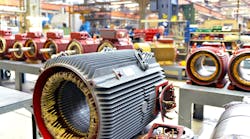Get your motor runnin’: Key takeaways from the 2021 EASA event
On June 28 I flew back from Fort Worth after my first time attending the EASA Annual Convention and Solutions Expo, and boy are my arms tired!
This article is part of our monthly From the Editor column. Read more from Thomas Wilk.
OK, it’s a dad joke, but it’s one of my father’s favorites, along with, “Do you know what time it is? No, but if you hum a few bars, I’ll fake it!” As dad jokes go, it’s hard to think of better ones.
But back to the event, which was terrific. The EASA team made this first-timer feel at home immediately, from the warm welcome I received from Linda Raynes, EASA president and CEO, to all of the plant workers, motors specialists, and energy industry experts that I met and spoke with over the long June 26-29 weekend. I even got to meet senior technical support specialist Tom Bishop, P.E., and thank him in person for contributing so many well-received articles to Plant Services.
However, the learning session delivered by industry expert Jerry Peerbolte delivered the most eye-opening information of the event. Jerry is an assistant professor of marketing at the University of Arkansas – Fort Smith; before that, he worked for 20 years at Baldor Electric Company (now ABB), the last 12 as their marketing VP. He also has worked closely with EASA for many years, delivering workshops, training sessions, and research presentations.
This year, he presented “Growing Your Business: Key Info from the Manufacturer/Supplier Community,” which summarized the results of a research project for which he conducted 31 interviews with 17 companies across the U.S., Canada, and Europe. His goal was to get a better understanding of the industry trends that companies are observing, and how they are positioning themselves in response to these trends.
The best of both maintenance worlds: PM optimization and digital tech
Oh, the places you’ll go in pursuit of maintenance and reliability improvements
In a world full of distractions, be the steady leader your team needs
One of the first trends Jerry talked about was what he termed the “rising hp rating for replace,” with his interview subjects observing that many end users are now considering any motors less than 75-100 hp to be candidates for replacement over repair. This represents a big change from the norm, which used to hover more around 50 hp.
A connected point came as less of a surprise: the rise of internet procurement options for motors and drives where price is the leading differentiator. Two consequences of this trend are (1) plants are placing less importance on brand differences when selecting motors, and (2) a range of industry sources from distributors to service centers and the business media have a crucial role to play in keeping plant teams informed of technology advances.
Jerry concluded by sketching out a vision of a future state five years from now, where plants have evolved from on-site condition monitoring to a maintenance model based on performance outcomes. In this future, data collection has shifted from on-premise to the cloud, and data analysis and decision-making is increasingly becoming the responsibility of the maintenance contractor.
Do you recognize you or your plant in these research results?
This story originally appeared in the July 2021 issue of Plant Services. Subscribe to Plant Services here.


